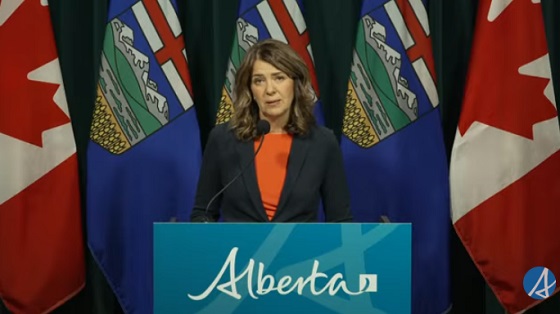Alberta
Fraser Institute says Albertans should get annual dividend to promote Heritage Fund

From the Fraser Institute
By Tegan Hill and Joel Emes
An Alberta Dividend: The Key to Growing the Heritage Fund
If the government of Alberta wants to build the Heritage Fund over the longer term, it should start paying dividends to Albertans, finds a new study published today by the Fraser Institute, an independent non-partisan Canadian think-tank.
“The Alberta government has promised to ‘re-build’ the Heritage Fund, but it will require a consistent commitment over the long term,” said Tegan Hill, director of Alberta Policy at the Fraser Institute and co-author of An Alberta Dividend: The Key to Growing the Heritage Fund.
In 1976, the province established the Alberta’s Heritage Savings Trust Fund to save a share of the province’s resource revenues to provide ongoing benefits to Albertans. Since its creation, however, resource revenue contributions have only been made in 11 of 48 years of the fund’s existence and just 3.9 per cent of total resource revenue has been deposited to the fund over its lifetime.
Learning from Alaska’s success with its resource revenue savings fund—the Alaska Permanent Fund—the study proposes that Alberta should introduce a dividend to provincial residents to create public buy-in that generates political pressure to adhere to fiscal rules around the Heritage Fund’s operation—such as consistent resource
revenue contributions and inflation-proofing of the fund’s principal—to ensure its growth over time.
For perspective, the Permanent Fund was started the same year as Alberta’s Heritage Fund but has grown to US$78.0 billion in 2022/23—or C$88.6 billion—compared to a balance of just C$19.0 billion in Alberta’s Heritage Fund.
Using two alternatives based on Alaska, which includes mandatory 25 per cent resource revenue contributions and consistent inflation proofing of the fund’s principal, the Heritage Fund has the potential to pay each Albertan a total of $571 to $1,108 in dividends over the next three years—equivalent to $2,284 to $4,430 per family of four.
Under these rules, the Heritage Fund would be worth between $35.8 billion and $38.7 billion by 2026/27, while paying out between $2.9 billion to $5.5 billion in dividends to Albertans.
“As demonstrated in Alaska, by giving citizens an ownership share in the state’s resource fund, they demand that sound rules regarding the governance of the fund be adhered to.” said Hill.
- The Smith government has promised to “re-build” the Heritage Fund so that eventually its earnings are significant enough to replace volatile resource revenue in the budget. While this is a worthy goal, it will require a long-term commitment.
- Building on work from Hill, Emes, and Clemens (2021), this bulletin uses Alaska’s success with its resource revenue savings fund—the Alaska Permanent Fund—to demonstrate how the Smith government can introduce new fiscal rules to ensure growth in the Heritage Fund with a focus on the annual dividend.
- As demonstrated in Alaska, by giving citizens ownership shares in the state resources, they recognize their vested interest and demand that the state maximizes returns from such resources. Put simply, by creating public buy-in, the dividend generates political pressure to enforce robust fiscal rules around the fund’s operation to ensure its growth.
- Using two illustrative models based on the Alaska Permanent Fund, which includes mandatory 25 percent resource revenue contributions and consistent inflation proofing of the fund’s principal, each Albertan could be paid an estimated $148 to $297 in dividends in 2024/25, equivalent to $594 to $1,187 per family of four. From 2024/25 to 2026/27, each Albertan could receive a total of $571 to $1,108 in dividends, equivalent to $2,284 to $4,430 per family of four.
- Under these rules, the Heritage Fund would be worth between $35.8 billion and $38.7 billion by 2026/27, while paying out between $2.9 billion to $5.5 billion in dividends to Albertans.
Authors:
Alberta
Diploma Exams Affected: No school Monday as ATA rejects offer of enhanced mediation

Premier Danielle Smith, Minister of Finance Nate Horner, and Minister of Education Demetrios Nicolaides issued the following statement.
“Yesterday, the Provincial Bargaining and Compensation Office wrote to the Alberta Teachers’ Association (ATA) and formally requested an agreement to enter an enhanced mediation process.
“This process would have ensured that students returned to the classrooms on Monday, and that teachers returned to work.
“Negotiating would have continued with the ATA, Teachers’ Employer Bargaining Association (TEBA) and a third-party mediator to propose a recommended agreement.
“We are very disappointed that the Alberta Teachers’ Association refused this offer. Teachers and students should also be disappointed.
“PBCO made this offer to the ATA because the union has not made a reasonable offer and this strike is impacting students. Alberta’s government is trying to put kids first and bring an end to this strike.
“The offer of enhanced mediation provided a clear path to ending it.
“We want the same things as the ATA: More teachers. More pay for teachers. More educational assistants. And more classrooms.
“This strike has gone on too long and we are extremely concerned about the impact it is having on students.
“We are willing to consider further options to ensure that our next generation gets the world-class education they deserve. After about three weeks, a strike of this nature would reach the threshold of causing irreparable harm to our students’ education.
“The ATA needs to do what is right for its members, and for all Alberta students.
“If it refuses to do so, we will consider further options to bring this strike to an end.”
Diploma exam update
November diploma exams will be optional for students.
With instructional time in schools disrupted due to the teacher strike, the November 2025 diploma exams will now be optional for students. Students who wish to write a diploma exam may request to do so, and their school boards will accommodate the request.
The optional diploma exams apply to all schools provincewide. These exams will still take place on the currently scheduled dates.
Students who choose not to write the November diploma exams can still complete their courses and graduate on time. Their final grade will be based entirely on the school-awarded mark provided by their teacher.
Choosing not to write the November diploma exams will not affect a student’s ability to apply to, be accepted by, or attend post-secondary institutions after graduation.
No changes have been made to the January and June diplomas and provincial achievement tests.
Quick facts
- Students are automatically exempted from writing the November diploma exams but can request to write them.
- School boards must allow the student to write the diploma exam if requested.
Alberta
Alberta taxpayers should know how much their municipal governments spend

From the Fraser Institute
By Tegan Hill and Austin Thompson
Next week, voters across Alberta will go to the polls to elect their local governments. Of course, while the issues vary depending on the city, town or district, all municipal governments spend taxpayer money.
And according to a recent study, Grande Prairie County and Red Deer County were among Alberta’s highest-spending municipalities (on a per-person basis) in 2023 (the latest year of comparable data). Kara Westerlund, president of the Rural Municipalities of Alberta, said that’s no surprise—arguing that it’s expensive to serve a small number of residents spread over large areas.
That challenge is real. In rural areas, fewer people share the cost of roads, parks and emergency services. But high spending isn’t inevitable. Some rural municipalities managed to spend far less, demonstrating that local choices about what services to provide, and how to deliver them, matter.
Consider the contrast in spending levels among rural counties. In 2023, Grande Prairie County and Red Deer County spent $5,413 and $4,619 per person, respectively. Foothills County, by comparison, spent just $2,570 per person. All three counties have relatively low population densities (fewer than seven residents per square kilometre) yet their per-person spending varies widely. (In case you’re wondering, Calgary spent $3,144 and Edmonton spent $3,241.)
Some of that variation reflects differences in the cost of similar services. For example, all three counties provide fire protection but in 2023 this service cost $56.95 per person in Grande Prairie County, $38.51 in Red Deer County and $10.32 in Foothills County. Other spending differences reflect not just how much is spent, but whether a service is offered at all. For instance, in 2023 Grande Prairie County recorded $46,283 in daycare spending, while Red Deer County and Foothills County had none.
Put simply, population density alone simply doesn’t explain why some municipalities spend more than others. Much depends on the choices municipal governments make and how efficiently they deliver services.
Westerlund also dismissed comparisons showing that some counties spend more per person than nearby towns and cities, calling them “apples to oranges.” It’s true that rural municipalities and cities differ—but that doesn’t make comparisons meaningless. After all, whether apples are a good deal depends on the price of other fruit, and a savvy shopper might switch to oranges if they offer better value. In the same way, comparing municipal spending—across all types of communities—helps Albertans judge whether they get good value for their tax dollars.
Every municipality offers a different mix of services and those choices come with different price tags. Consider three nearby municipalities: in 2023, Rockyview County spent $3,419 per person, Calgary spent $3,144 and Airdrie spent $2,187. These differences reflect real trade-offs in the scope, quality and cost of local services. Albertans should decide for themselves which mix of local services best suits their needs—but they can’t do that without clear data on what those services actually cost.
A big municipal tax bill isn’t an inevitable consequence of rural living. How much gets spent in each Alberta municipality depends greatly on the choices made by the mayors, reeves and councillors Albertans will elect next week. And for Albertans to determine whether or not they get good value for their local tax dollars, they must know how much their municipality is spending.
-

 Red Deer16 hours ago
Red Deer16 hours agoThe City of Red Deer’s Financial Troubles: Here Are The Candidates I Am Voting For And Why.
-

 Business1 day ago
Business1 day agoCutting Red Tape Could Help Solve Canada’s Doctor Crisis
-

 espionage19 hours ago
espionage19 hours agoPEI to Ottawa: Investigate CCP Footprints—Now
-

 Alberta2 days ago
Alberta2 days agoAlberta taxpayers should know how much their municipal governments spend
-

 Alberta2 days ago
Alberta2 days agoPremier Smith addresses the most important issue facing Alberta teachers: Classroom Complexity
-

 Bruce Dowbiggin1 day ago
Bruce Dowbiggin1 day agoBrokeback President: We Can’t Quit You, Donald
-

 Energy1 day ago
Energy1 day agoPrince Rupert as the Optimal Destination Port for an Alberta Crude Oil Pipeline –
-

 Business17 hours ago
Business17 hours agoFederal Budget 2025: A responsible media would ensure Canadians know about the dismal state of federal finance









